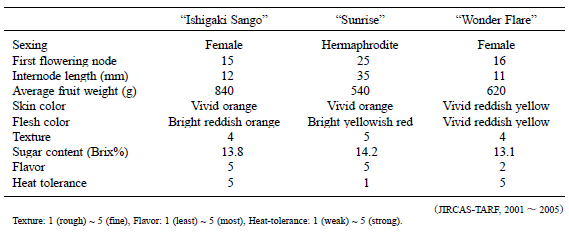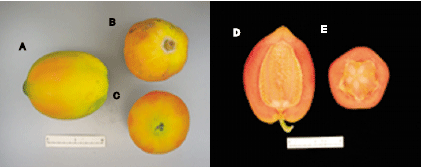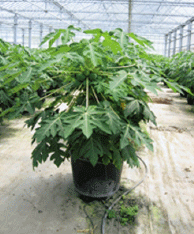“Ishigaki Sango,” a new variety of heat-tolerant dwarf papaya
Description
In Japan, papayas are produced from southern Kyushu to Okinawa, in the southernmost regions of Japan, and are consumed as a fruit and/or vegetable. The “Sunrise” fruit-type family is highly regarded both globally and in the Japanese market. However, this family takes the form of relatively tall trees, and at high and low temperatures, fruit abscission occurs due to male sterility. These two characteristics constrain papaya production in Japan’s growing areas in both summer, when temperatures are high, and winter, due to frequent typhoons. We therefore embarked on a program to breed a new heat-tolerant dwarf tree papaya for sub-tropical regions, with fruit quality equal to or better than the “Sunrise” family fruit.
The new papaya variety was found from a chance seedling of “Wonder Bright” in 1997. We planted it and other crossed seedlings in 1998 and selected it in 2000. This variety exhibits high fruit quality, is early bearing, and gives the highest yield of all the seedlings we raised. In 2007, the new variety was named “Ishigaki Sango” and registered with Japan’s Ministry of Agriculture, Forestry and Fisheries.
“Ishigaki Sango” has a dwarf tree form and is heat-tolerant. It is ever-bearing, producing parthenocarpic fruit with a high sugar content and good flavor and taste. Plants are exclusively female.
The average fruit weight is 840 g and the average sugar content is 13.8 Brix%. The skin color is vivid orange (Japanese standard horticultural plant color charts: No. 1605), the flesh is bright reddish orange (No. 1005), and the flavor and taste are good (Table 1, Fig. 1 and 2).
The tree form is dwarf because the first bearing node is the 15th, and average internode length is 12 mm, considerably shorter than in the “Sunrise” family. The average period from planting to first flowering is only 90 days. “Ishigaki Sango” is able to produce fruit throughout the year and down to 15 ℃, since it is parthenocarpic and thus not affected by male sterility at high and low temperatures.
Figure, table
-
Table 1. Fruit and tree characteristics of “Ishigaki Sango.”
-
Fig. 1. Fruit of “Ishigaki Sango.”
A: fruit side, B: stem end, C: fruit apex.
D: longitudinal cross section, E: transverse cross section. -
Fig. 2. Fruiting of “Ishigaki Sango” potted tree.
- Affiliation
-
Japan International Research Center for Agricultural Sciences Tropical Agriculture Research Front
- Term of research
-
FY2005(FY1997~2005)
- Responsible researcher
-
FUKAMACHI Hiroshi ( Institute of Fruit Tree Science, NARO )
KATO Hidenori ( Tropical Agriculture Research Front )
HIDAKA Tetsushi ( Kagoshima University )
TAMASHIRO Masao ( Ishigaki-Island Papaya )
OGAWA Kazunori ( Institute of Fruit Tree Science, NARO )
KOMORI Sadao ( Iwate University )
YONEMOTO Yoshimi ( Tropical Agriculture Research Front )
- ほか
- Publication, etc.
-
Variety registration pending
- Japanese PDF
-
2006_seikajouhou_A4_ja_Part23.pdf590.59 KB



